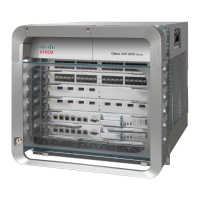112
Cisco ASR 9000 Series Aggregation Services Router Getting Started Guide
OL-28417-02
Introduction to the Cisco ASR 9000 Series Aggregation Services Router
Cisco ASR 9000 Series Router Overview
L2VPN
The router uses L2VPNs, which offers the following:
• Virtual Private LAN Services (VPLS)—VPLS is a class of VPN that supports the connection of
multiple sites in a single, bridged domain over a managed IP/MPLS network. It presents an Ethernet
interface to customers, simplifying the LAN and WAN boundary for service providers and
customers, and enabling rapid and flexible service provisioning because the service bandwidth is
not tied to the physical interface. All services in a VPLS appear to be on the same LAN, regardless
of location.
• Hierarchical VPLS (H-VPLS)—H-VPLS provides a level of hierarchy at the edge of the VPLS
network for increased scale. QinQ access and H-VPLS pseudowire access options are supported.
• Virtual Private WAN Services/Ethernet over MPLS (VPWS/EoMPLS)—EoMPLS transports
Ethernet frames across an MPLS core using pseudowires. Individual EFPs or an entire port can be
transported over the MPLS backbone using pseudowires to an egress interface or subinterface.
• Pseudowire redundancy—Pseudowire redundancy supports the definition of a backup pseudowire to
protect a primary pseudowire that fails.
• Multisegment pseudowire stitching—Thisis a method used to interwork two pseudowires together
to form a cross-connect relationship.
• G.8032 Support—This feature implements the Automatic Protection Switching (APS) protocol and
protection switching mechanisms for Ethernet layer ring topologies. For more information on
G.8032 support, see the Cisco ASR 9000 Series Aggregation Services Router L2VPN and Ethernet
Services Configuration Guide.
• Multiple Spanning Tree Access Gateway (MSTAG) Edge Mode—Using this feature, you can
configure the MSTAG in such a way that the gateway devices have the best path to the best possible
Multiple Spanning Tree Protocol (MSTP) root node. For more information on MSTAG Edge mode,
see the Cisco ASR 9000 Series Aggregation Services Router L2VPN and Ethernet Services
Configuration Guide.
• Virtual Private LAN Services (VPLS) Support on ASR 9000 SIP-700—VPLS is a mechanism for
transporting Ethernet traffic across multiple sites that belong to the same L2 broadcast domain. This
feature builds a point-to-point connection to interconnect two customer sites. For more information
on VPLS support, see the Cisco ASR 9000 Series Aggregation Services Router L2VPN and Ethernet
Services Configuration Guide.
• Circuit Emulation Mode (CEM) 24 T1/E1, T3/E3—This feature allows network administrators to
use the existing IP/MPLS network to provide leased-line emulation services or to carry data streams
or protocols that do not meet the format requirements of other multiservice platform interfaces. For
more information on CEM, see the Cisco ASR 9000 Series Aggregation Services Router L2VPN and
Ethernet Services Configuration Guide.
• MLD Snooping— This feature provides a way to constrain multicast traffic at Layer 2. By snooping
the MLD embership reports sent by hosts in the bridge domain, the MLD snooping application can
set up Layer 2 multicast forwarding tables to deliver traffic only to ports with at least one interested
membersignificantly reducing the volume of multicast traffic. For more information on MLD
Snooping, see the Cisco ASR 9000 Series Aggregation Services Router Multicast Configuration
Guide.
• L2VPN Nonstop Routing (NSR) and L2VPN Scale Enhancements— This feature enables to avoid
label distribution path (LDP) sessions from flapping on events such as process failures (cras h) and
route processor failover (RP FO). For more information on L2VPN NSR, see the Cisco ASR 9000
Series Aggregation Services Router L2VPN and Ethernet Services Configuration Guide.

